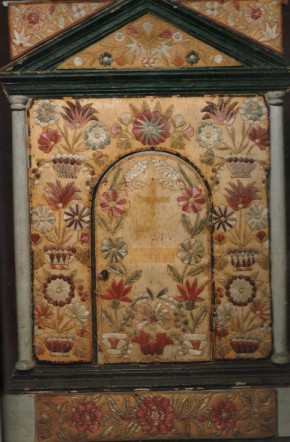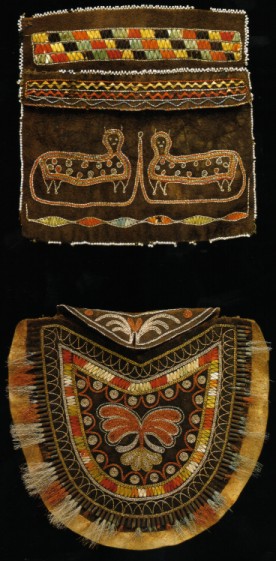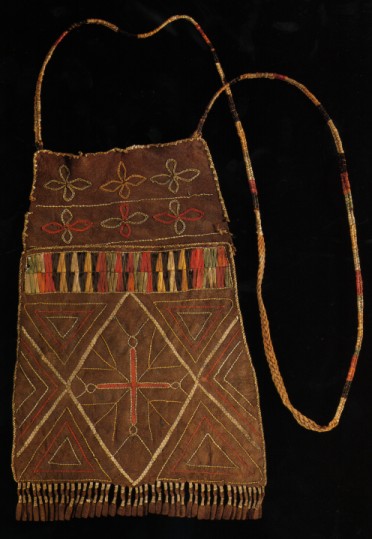|
|
Canku Ota |
|
|
(Many Paths) |
||
|
An Online Newsletter Celebrating Native America |
||
|
October 20, 2001 - Issue 47 |
||
|
|
||
|
Quillwork-Part Two |
||
|
by Lynne Sageflower Pennington |
| In this Issue we will learn about the tools of the trade, different techniques, designs, quillwork on birch bark and on leather. | |
|
|
|
|
Quill-embroidered birch bark panel- Michigan 1846-48 |
|
|
|
| Lets start off with the tools of the trade. |
| Tools you will need to have on hand when doing quillwork |
| Needles |
| The best needles to use are beading- size 12 , and gloverís. |
| Thread |
| Size 0 or 00 Nymo thread, always have beeswax on hand the run your threads thru. It helps to keep fraying down should it occur. You can use thin sinew, I also run this thru the beeswax also. |
| Ruler |
| This helps to measure the length of your quills besides measuring lengths between designs. |
| Scissors |
| A good sharp pair for cutting quills and a good pair to cut Birch bark or Leather. I personally have two separate pairs I use on birch back and one for leather. The best pair of scissors I have found for cutting leather are by |
| Awl |
| Mainly used for when working with birch bark. A fine pointed awl is used. |
| Masking Tape |
| Place masking tape on the bark of the leather you are working with to prevent it from stretching while you work |
|
|
| Designs | |
| Before you start to do the quilling it is best to have your design in mind and what materials you are going to do it on, birch bark or leather. Then you will now what technique you want to use, so lets start off with this first. | |
|
|
|
|
Top: Ottawa Pouch -1800 |
Menominee Shoulder Bag- 1800-30 |
| Designs range from floral & plant patterns, geometric patterns, animal patterns and line work such as curves. When doing a design on birch bark cut outs were often used. | |
| For designs I have looked in several books, from American Indian art books, American Indian craft books to coloring books, stencils for walls, Appliqué books, on the web, Quilting books, Stain Glass patterns and several other places. I use these methods for several crafts I want to do. | |
| Getting the design on the leather or birch bark | |
| The old time way to get the impression on the leather was with a form of ink made from berry juice. A thin stick would be dipped into the juice then the design would be draw on the leather. Today we have marking pens or pencils that disappear or can be smudged off. | |
| For making impressions of a design on birch bark it was done by lightly scraping the design using a small piece of bone or a knife. | |
|
|
|
| Techniques: |
| There are certain ways to do these techniques on Leather and Birch bark. Loom Quillwork has yet another way for quillwork. |
| There is no way I can explain and show you graphics for each technique because it would take several issues to do so. My advice is to get the book called A Quillwork Companion by Jean Heinbuch. For me it is my Quillwork Bible. Jeanís book does each techniques not only with steps but with graphics so it is easy to understand. I found her book the best to work with for teaching new quillworkers about quillwork. As a matter of fact I have given her book as a gift to several friends who what to learn to do quillwork. Sometimes it is better to let people see for themselves how to do the techniques then teaching them personally. Jeans' book also gives you a list of Old Time Dyes. |
| Another woman I admire for her quillwork is Nancy Fonicello. She is really outstanding. She has a web site which I will list below. You can find some of the techniques she has illustrated on Tara Prindlesís Native Tech web site. Not all the techniques are on the site but she does show you some of them including steps and graphics. Tara Prindles' web site is also listed below. |
|
|
| There are numerous techniques some are simple and some are more complex. |
| Simple Techniques: |
| Zig-Zag, Simple Band, Single Thread line, Quill wrapping, Quill Plaiting, Coiling Wrapping, Rosettes and Loom. |
| More Complex Techniques: |
| Two quill Zig-Zag, Two quill Triangle, Two Quill Diamond, Three Quill Double Diamond, Multiple Quill Plait, Checker Weave, Single Thread Sawtooth, Zig-Zag Edging Technique, Wrap Fill Edge . |
| My advice before you start getting into the fancy quillwork, is to start with just drawing two lines on a piece of leather about 1/4" to 3/8" inches apart and practice doing the techniques until you feel comfortable doing them. Try the Zig-zag or Simple band. |
| My advice for children is to let them learn Quill wrapping first. You can purchase kits for them to learn with from Noc Bay Trading or Crazy Crow Trading. I will list their web sites below in Craft Suppliers. |
| If you do not want to try doing quillwork yourself but would rather purchase quillwork there are numerous women whom are keeping this art alive. Some of their sites are listed below. |
|
|
| Web Sites on Quillwork that you can purchase or have something custom made: |
| I am a firm believer in the Indian Arts & Crafts Act of 1990 so remember if you want to purchase an Item that is " Indian Made" make sure you check their credentials first before you buy. |
|
Nancy Ann Fonicello |
|
Minx & Tim's Camp: Custom Quillwork And Wampum |
|
Northern Plains Quillwork by Ravenshead Tiwahe |
|
K & M Creations |
|
The FolkArt & Craft Exchange proudly presents Native American Style Quillwork |
|
Little Wings Traditional Quill Work |
|
Eagle Mountain Trading |
|
Deborah Magee Sherer-"Traditional and Contemporary" Native Beadwork and Quillwork |
|
Red Thunder |
|
Buckboard Trading Post |
|
Although Christy is not American Indian she has some beautiful pieces check them out |
|
|
| Web Sites for Information |
|
Quill and Beadwork |
|
Native Tech |
|
Matoska Trading |
|
|
| Books that are mainly about Quillwork | |
|
|
|
|
|
|
|
|
|
|
|
| Some books that contain sections or references about Quillwork | |
|
|
|
|
|
|
|
| Art Books with pictures of Past Quillwork | |
|
|
|
|
|
|
| In the Next Issue I will be covering the Art of Ribbonwork. History of ribbonwork, Instructions on how to do Ribbonwork, designs and terms. | |
|
|
||
|
|
||
| Canku Ota is a free Newsletter celebrating Native America, its traditions and accomplishments . We do not provide subscriber or visitor names to anyone. Some articles presented in Canku Ota may contain copyright material. We have received appropriate permissions for republishing any articles. Material appearing here is distributed without profit or monetary gain to those who have expressed an interest. This is in accordance with Title 17 U.S.C. section 107. | ||
|
Canku Ota is a copyright © 2000, 2001 of Vicki Lockard and Paul Barry. |
||
|
|
|
|
|
The "Canku Ota - A Newsletter Celebrating Native America" web site and its design is the |
||
|
Copyright © 1999, 2000, 2001 of Paul C. Barry. |
||
|
All Rights Reserved. |
||



